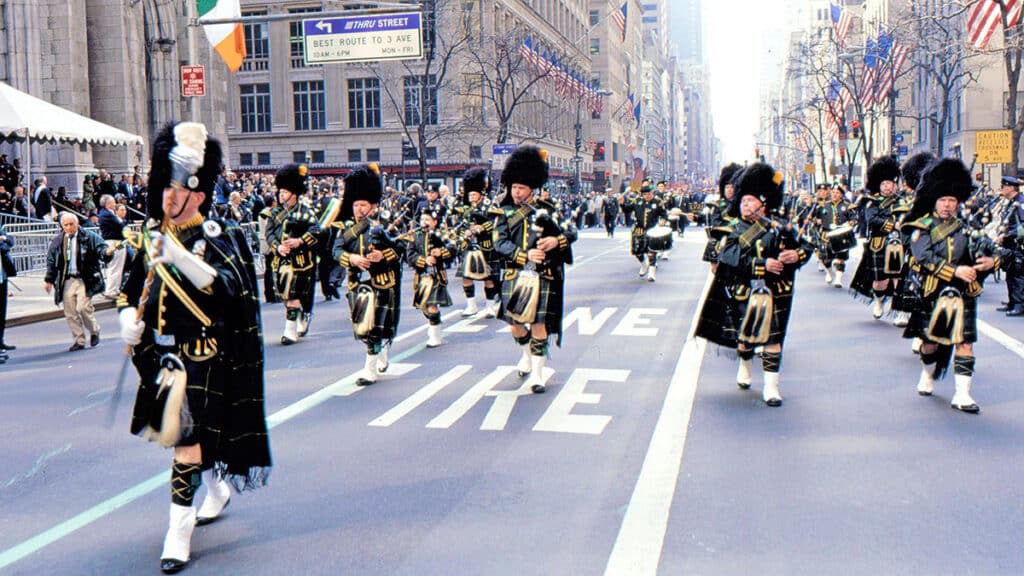The NYC St Patrick’s Day Parade 2025 honors Saint Patrick, the patron saint of Ireland.
This beloved New York tradition began on March 17, 1762 when New York was still British. That was fourteen years BEFORE the U.S. Declaration of Independence in 1776. The first parade was made by Irish patriots serving in the British Army. At the time, wearing green was forbidden in Ireland. Wow! Today, around 250,000 people march in the parade in front of around 2 million spectators.
New York City actually has several Saint Patrick’s Day Parades. Manhattan’s is the big one.
- Queens County St Patrick’s Day Parade is in Rockaway, Queens on the first Saturday in March. queenscountyparade.org 🇮🇪
- Throggs Neck St Patrick’s Day Parade is in Throggs Neck, The Bronx, on the second Sunday in March. tnsaintpatricksdayparade.blogspot.com 🇮🇪
- NYC St Patrick’s Day Parade is in Midtown, Manhattan on St Patrick’s Day, March 17 (or on Saturday when Paddy’s Day is Sunday). 🇮🇪
264th NYC St Patrick’s Day Parade 2025 in Manhattan

The Parade is the climax of several community events:
- Grand Marshal and Aides Reception. nycstpatricksparade.org 🇮🇪
- St Patrick’s Foundation Gala. stpatricksdayfoundation.org 🇮🇪
- Irish Flag Raising. 🇮🇪
- NYC Saint Patrick’s Day Parade marches up Fifth Avenue, from 44th St to 79th St on St. Saturday, March 16, 2024, from 11am to around 4:30pm. FREE. (NOTE: It’s Saturday, not Sunday St Patrick’s Day) nycstpatricksparade.org 🇮🇪
- Scholarship applications are due Thursday, April 11, 2024 at 11pm. Scholarship winners will be announced on Friday, May 17, 2024.
Where to Watch the Parade
The Parade marches up Fifth Avenue
- START: 44th St in Midtown | Midtown East
- END: 79th St in Central Park | Upper East Side
The Parade is broadcast live on NBC 4 at 11am, and can be streamed at nycstpatricksparade.org
The Parade is very popular. For best viewing, the early bird gets the worm. But beware, there are no restrooms on the parade route.The Parade goes on rain or shine. A cold rain or snow never stopped the Irish. It feels like home.
You can request grandstand seats by mail on a first-come, first-serve basis. Requests must be received by March 1. nycstpatricksparade.org
2025 Grand Marshall and Aides
To be announced.
2025 Scholarships
To be announced.
For research paper topic, and scholarship details, visit nycstpatricksparade.org
263rd NYC St Patrick’s Day Parade 2024 Manhattan
The Parade is the climax of several community events:
- The Grand Marshal and Aides Reception is at Antun’s restaurant in Queens Village; on February 25, 2024 at 3pm. nycstpatricksparade.org 🇮🇪
- The St Patrick’s Foundation Gala raises scholarship funds at the New York Marriott Marquis in Manhattan’s Times Square Theater District; on March 13, 2024, at 6pm. stpatricksdayfoundation.org 🇮🇪
- The Irish Flag Raising is at Bowling Green in Manhattan’s Financial District; on March 15, 2024 at 12 noon. FREE. 🇮🇪
- Manhattan’s Saint Patrick’s Day Parade marches up Fifth Avenue, from 44th St to 79th St on Saturday, March 16, 2024, from 11am to around 4:30pm. FREE. (NOTE: It’s Saturday, not Sunday St Patrick’s Day) nycstpatricksparade.org 🇮🇪
- Scholarship applications are due Thursday, April 11, 2024 at 11pm. Scholarship winners will be announced on Friday, May 17, 2024.
Where to Watch the Parade
The Parade marches up Fifth Avenue
- START: 44th St in Midtown | Midtown East
- END: 79th St in Central Park | Upper East Side
The Parade is broadcast live on NBC 4 at 11am, and can be streamed at nycstpatricksparade.org
The Parade is very popular. For best viewing, the early bird gets the worm. But beware, there are no restrooms on the parade route.The Parade goes on rain or shine. A cold rain or snow never stopped the Irish. It feels like home.
You can request grandstand seats by mail on a first-come, first-serve basis. Requests must be received by March 1. nycstpatricksparade.org
2024 Grand Marshall and Aides
The 2024 Grand Marshal is Margaret C. Timoney, President and CEO of Heineken USA. 🇮🇪
- New York County: Msgr. Donald Sakano
- Bronx County: John “Jack” McCarrick
- Queens County: Bridget A. Rush-Hernandez
- Kings County: JoAnn Gundersen
- Richmond County: Yvonne F. Sheehan
- Rockland County: Sean M. Walsh
- Nassau County: Paul R. Doud
- Orange County: Donald J. “Don” Higgins
- Suffolk County: Rev. Henry W. Reid
- Westchester County: Margaret A. “Peggy” Flynn
- United Irish Counties: Michael J. O’Reilly
- Grand Council of United Emeralds Society: Superintendent Edward T. Cetnar
- Knights of St Patrick: Sheila R. Clancy McCarthy
- Aide at Large: Treasa C. Goodwin-Smyth
- Archdiocese of N.Y.: William E. Whiston
- F.D.N.Y.: Lt. John J. Meara
- N.Y.P.D.: Dep. Inspector William J. Gallagher
2024 Scholarships
The Parade awards scholarships, from $750 – $4,000 to both high school and college level students, based on a Research Paper Contest.
- 2024 scholarship applications must be emailed by Thursday, April 11, 2024 at 11pm.
- 2024 Research Paper Contest Winners will be announced on Friday, May 17, 2024.
For research paper topic, and scholarship details, visit nycstpatricksparade.org
More Information
nycstpatricksparade.org 🇮🇪
Instagram @nycstpatricksdayparade 🇮🇪
